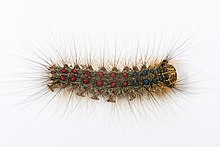| Lymantria dispar | |
|---|---|

| |
| Mounted Lymantria dispar dispar male | |

| |
| Mounted Lymantria dispar dispar female | |
| Scientific classification | |
| Domain: | Eukaryota |
| Kingdom: | Animalia |
| Phylum: | Arthropoda |
| Class: | Insecta |
| Order: | Lepidoptera |
| Superfamily: | Noctuoidea |
| Family: | Erebidae |
| Genus: | Lymantria |
| Species: | L. dispar
|
| Binomial name | |
| Lymantria dispar | |
| Subspecies | |
| Synonyms | |
| |

Lymantria dispar, also known as the gypsy moth[1][2] or the spongy moth,[3][4] is a species of moth in the family Erebidae native to Europe and Asia. Lymantria dispar is subdivided into several subspecies, with subspecies such as L. d. dispar and L. d. japonica being clearly identifiable without ambiguity. Lymantria dispar has been introduced to several continents and is now additionally found as an invasive species in Africa, North America and South America. The polyphagous larvae live on a variety of deciduous and coniferous trees[5] and can cause severe damage in years of mass reproduction. Due to these features, Lymantria dispar is listed among the world's 100 worst invasive alien species.[6]
- ^ Gypsy Moth Lymantria dispar at UK Moths
- ^ "Bug experts seeking new name for destructive gypsy moths". king5.com. July 9, 2021. Retrieved July 10, 2021.
- ^ ""Spongy Moth" Proposed as New Common Name for Lymantria Dispar". entsoc.org. January 25, 2022.
- ^ "'Spongy Moth' Adopted as New Common Name for Lymantria dispar". Entomological Society of America. Retrieved 3 March 2022.
- ^ FAO - Profiles of selected forest pests[permanent dead link]
- ^ "100 of the World's Worst Invasive Alien Species". Global Invasive Species Database. Archived from the original on 2016-03-04. Retrieved 5 September 2018.